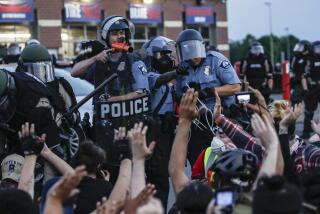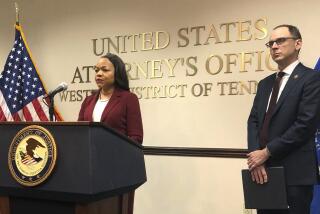How bad were things in Ferguson? Police officers tell their stories

Demonstrators marking the anniversary of the shooting of Michael Brown confront police along West Florrisant Street on Aug.11, 2015, in Ferguson, Mo.
As stressed-out officers policed last year’s protests in Ferguson, Mo., it was sometimes hard for them to know who was in charge as more than 50 law enforcement agencies swarmed the suburb. Sometimes they had confusing directions.
When they got home, some argued with their spouses. Hackers stole officers’ identities. As the streets seethed with anger for 17 days over an officer’s shooting of 18-year-old Michael Brown, authorities were exasperated by opportunistic burglars running amok.
On Thursday, the Department of Justice’s Office of Community Orienting Policing Services released a damning report that primarily slammed the police response to the August 2014 protests in Ferguson, confirming what had been documented by news coverage and social media users. The heavy-handed tactical response by the Missouri State Highway Patrol, St. Louis County police, St. Louis city police, and the Ferguson Police Department often worsened the unrest and at times was unconstitutional.
The report found that the snipers perched on top of armored vehicles frightened and angered unarmed crowds. The use of police dogs went against national recommendations and echoed images from the worst moments of the Civil Rights Movement of the 1960s. Tear gas was sometimes launched without warning and too close to homes. A five-second “keep moving” rule violated the First Amendment right to assemble.
But another insightful component of the report compiled from 160 anonymous interviews from November to May offered rare behind-the-scenes accounts of how front-line officers and upper-level officials saw the protests.
In their own words:
“In over 20 years of working here, this crowd was unlike anything I had ever seen.” —St. Louis-area police supervisor
The size, speed and anger of the crowd that gathered around Brown’s body after he was shot by Ferguson Officer Darren Wilson on Aug. 9, 2014, stunned officials. The roughly 200 people on Canfield Drive occasionally scattered police with gunshots and set the tone for the unrest to come.
“Boss we have had a bad afternoon up here,” a St. Louis County tactical response captain recalled telling St. Louis County Police Chief Jon Belmar. “We almost didn’t get this crime scene processed. We had a lot of gunshots and people surrounded the body.”
“I honestly don’t know how all of this happened — I’m at a loss to explain,” a police supervisor said of the initial crowd. “The pulse of the situation was different.”
“We just abandoned Canfield Green Apartments.” —An officer
The scene grew so hostile and chaotic on Canfield Drive and on nearby West Florrisant Avenue that police gave up responding to normal calls for service at the apartment complex where Brown lived and near where he was shot.
“Canfield Apartments became a no-police zone,” one officer said. “We were told we could not go into Canfield Apartments. We contained the area but did not go into the area, and by default the area became a safe haven for criminals.”
Some residents told the Justice Department that they felt police had “abandoned” the complex, and some officers felt they abandoned the riot scene. As looters ravaged stores on Aug. 15, Missouri Highway Patrol Capt. Ron Johnson, the incident commander, told officers not to intervene because he thought it would put rioters, protesters and officer’s lives at risk.
“It was difficult for law enforcement officers to stand by and watch the criminal activity taking place and do nothing about it,” one officer said.
Johnson, a black native of Ferguson, was praised by the public for his more conciliatory approach, but officers complained privately that he spent more time interacting with the public than with coordinating the police response and said morale dipped because he made sympathetic remarks about protesters.
“We gave up a city; we are unclear who we can arrest; and everybody thinks they’re special and the rules don’t apply to them.” —An officer
The report noted deep tension between the police agencies. In the beginning, it was unclear whether Ferguson or St. Louis County police were in charge.
Area officials didn’t set up a formal command structure like they should have, the report said. Some officers pitching in from smaller area departments did not seem as well trained. Direction from leaders on whether or when to arrest demonstrators shifted constantly.
“What should we be doing? How should we be doing it?” an officer said. “Citizens became bolder by the third or fourth day — shooting drugs, stealing in front of officers. Police were on their heels because what we could or could not do changed every single day.”
“We have to keep our people safe. Sometimes policing is not pretty.” —A police commander
The federal report condemned deploying snipers on top of armored vehicles, pointing their guns at protesters in “overwatch” in case a gunman appeared in the crowd. The authors also criticized keeping armored vehicles on the front lines of protests and the use of military-looking camouflage uniforms by St. Louis County police.
However, the report did not fully condemn the so-called “militarized” tools used by police, saying “some tactical response was necessary as a result of increased aggression by some of the protesters.”
Some of the BearCat tactical vehicles were struck by bullets, and were used to rescue gunshot victims. Local agencies reported that at least 39 officers were hurt during the protests.
Some officers reported being told not to wear protective gear because of the intimidating message it sent, and they said they felt “a sense of abandonment” and that “public image trumped officer safety.”
“I was noticing that I was arguing with my wife at home.” —An officer
Officers privately felt uncharacteristically irritable and angry. They lost sleep and grappled with the stress put on relationships with their loved ones, whom they sometimes couldn’t check on during the protests.
Repeated 12-hour shifts and extensive verbal abuse from some protesters put officers on edge; African American officers in particular took the worst invective, often being called “Uncle Toms.” Some officers refused to wear name badges despite orders from superiors, the report said.
Making matters worse, hackers, apparently inspired by the hacking collective Anonymous, infiltrated area police departments’ servers and stole officers’ personal information, the report said. Identity thieves took out credit cards in officers’ names, put liens on their property and filed false tax claims
“I was getting calls from news organizations all over the world. Small-town papers and network news all wanted information, and everyone wanted to interview the chief.” —A St. Louis County police spokesman, on the day after Brown’s death
Area police agencies, who would be widely criticized for how they released information and handled media during the protests, were swiftly overwhelmed by the widespread attention and the size and influence of the social-media response. The report confirmed that the agencies fell behind on social media.
The command center allowed only one spokesman to directly handle the massive media response, and a team of public information officers was unable to handle all the requests despite working 20-hour days, the report said.
“When the St. Louis County [police spokesman] went home late, he awoke after a few hours to find that he had more than 80 new messages,” the report said.
Officials also groused about some of the news coverage, saying that outlets published or broadcast inaccurate or misleading stories.
“If you watched the news, it looked like the whole city was on fire,” one officer said. “But it was really [only] two blocks.”
Follow @MattDPearce for national news
More to Read
Start your day right
Sign up for Essential California for news, features and recommendations from the L.A. Times and beyond in your inbox six days a week.
You may occasionally receive promotional content from the Los Angeles Times.







